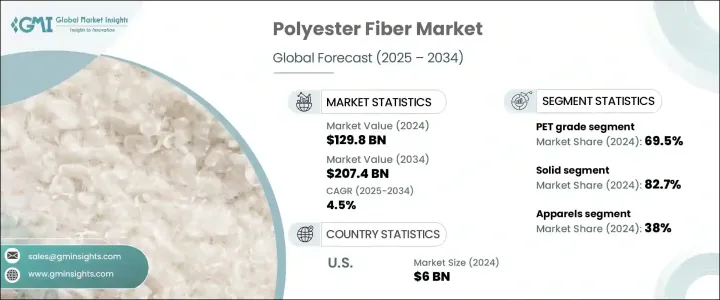
세계의 폴리에스테르 섬유 시장은 2024년 1,298억 달러로 평가되었으며, 2025년부터 2034년까지 연평균 복합 성장률(CAGR) 4.5%를 나타낼 것으로 예측됩니다.
석유화학제품에서 합성되는 폴리에스테르 섬유는 주로 그 강도, 내구성, 유연성, 비용 대비 효과에 의해 세계에서 가장 범용성이 높고, 널리 사용되고 있는 합성 섬유의 하나입니다. 산업계가 기능성과 지속가능성을 높인 고성능 소재를 계속 요구하는 가운데, 폴리에스테르 섬유 는 섬유, 자동차, 가정용 가구, 산업용도 등 여러 분야에서 최유력 후보로 부상하고 있습니다.

또한 환경 친화적인 섬유 및 재활용 섬유의 제조와 같은 생산 기술의 혁신이 진행되고 있는 것도 세계 시장을 견인하고 있습니다. 또한 세계 시장 관계자는 생산 능력과 제품 포트폴리오를 강화하기 위해 전략적 제휴, 합병, 인수에 주력하고 있으며, 시장 확대를 더욱 뒷받침하고 있습니다.
| 시장 범위 | |
|---|---|
| 시작 연도 | 2024년 |
| 예측 연도 | 2025-2034년 |
| 시작 금액 | 1,298억 달러 |
| 예측 금액 | 2,074억 달러 |
| CAGR | 4.5% |
폴리에스테르 섬유 시장은 등급별로 PET(폴리에틸렌테레프탈레이트)와 PCDT(폴리-1,4-시클로헥실렌디메틸렌테레프탈레이트)로 구분됩니다. 2024년에 69.5%의 점유율을 차지해 시장을 독점했지만, 이것은 주로 의류, 포장, 공업용 섬유에 폭넓게 사용되고 있기 때문입니다. PET 섬유는 새로운 소재에 리사이클할 수 있기 때문에 지속가능성의 목표를 효과적으로 서포트할 수 있습니다.
제품 유형별로 보면 폴리에스테르 섬유 시장은 고형 섬유와 중공 섬유로 나뉘어 2024년에는 고형 폴리에스테르 섬유가 82.7%의 점유율을 차지했습니다. 고형 섬유는 강도, 내구성, 손질의 용이함 필요한 의류, 침구, 의자, 기타 섬유 제품에 널리 사용되고 있기 때문에 계속 지지를 모으고 있습니다. 땅에의 기호가 높아지고 있는 것이, 폴리에스테르 고형 섬유 수요를 밀어 올리고 있습니다. 또한, 기능성과 함께 미적 매력을 중시하는 가정 장식품이나 인테리어 가구의 동향도, 이 분야의 성장에 기여하고 있습니다. 소비자도 제조업체도 마찬가지로, 고형 폴리에스테르 섬유를 다양한 용도의 비용효과가 높고 고품질의 솔루션으로서 인식하고 있어 현대의 텍스타일에 빠뜨릴 수 없는 구성 요소가 되고 있습니다.
미국의 폴리에스테르 섬유 시장 규모는 2024년에 60억 달러가 되어, 견조한 산업 수요, 고도의 제조 능력, 유리한 무역 정책에 견인되어 계속 주도적 지위를 차지했습니다. 발달한 섬유 산업과 국내 제조 중시의 고조가 세계의 폴리에스테르 섬유 시장에서 미국의 아성을 강화하고 있습니다. 합성 섬유, 특히 폴리에스테르의 수입이 증가하고 있는 것은 미국 전체에서 패션, 가정용 섬유, 공업 용도로 이러한 만능 소재의 요구가 높아지고 있는 것을 부각하고 있습니다.
The Global Polyester Fiber Market, valued at USD 129.8 billion in 2024, is projected to grow at a CAGR of 4.5% from 2025 to 2034. Polyester fiber, synthesized from petrochemicals, remains one of the most versatile and widely used synthetic fibers worldwide, primarily due to its strength, durability, flexibility, and cost-effectiveness. As industries continuously seek high-performance materials that offer enhanced functionality and sustainability, polyester fiber emerges as a top contender across multiple verticals, including textiles, automotive, home furnishings, and industrial applications. The rising demand for low-maintenance, wrinkle-resistant, and quick-drying fabrics in the fashion and home decor segments is accelerating the use of polyester fibers.

Additionally, ongoing innovations in production technologies, such as eco-friendly and recycled fiber manufacturing, are driving the global market forward. Heightened consumer awareness about sustainable and durable materials, coupled with increasing demand for affordable synthetic alternatives to natural fibers, is reinforcing polyester fiber's dominance. Moreover, global market players are focusing on strategic collaborations, mergers, and acquisitions to strengthen their production capacities and product portfolios, further fueling market expansion. The shift toward circular economies and the rising incorporation of recycled polyester in textiles are also shaping the industry's growth trajectory.
| Market Scope | |
|---|---|
| Start Year | 2024 |
| Forecast Year | 2025-2034 |
| Start Value | $129.8 Billion |
| Forecast Value | $207.4 Billion |
| CAGR | 4.5% |
The polyester fiber market is segmented by grade into PET (polyethylene terephthalate) and PCDT (poly-1,4-cyclohexylene-dimethylene terephthalate). PET grade dominated the market with a 69.5% share in 2024, primarily due to its extensive use in clothing, packaging, and industrial fabrics. Known for its durability, lightweight nature, and excellent resistance to moisture and chemicals, PET fiber continues to be favored in fashion and industrial applications alike. The increasing consumer focus on eco-friendly products is driving the demand for PET fibers since they can be recycled into new materials, effectively supporting sustainability goals. As consumers prioritize long-lasting, low-maintenance garments and products that offer value and performance, PET fibers remain the preferred choice for manufacturers looking to meet evolving market demands.
By product type, the polyester fiber market is divided into solid and hollow fibers, with solid polyester fibers capturing an 82.7% share in 2024. Solid fibers continue gaining traction owing to their widespread use in apparel, bedding, upholstery, and other textile products that require strength, durability, and ease of care. The growing preference for wrinkle-resistant, fast-drying, and resilient fabrics in both home and commercial sectors is pushing the demand for solid polyester fibers higher. Additionally, trends in home decor and interior furnishings that emphasize aesthetic appeal along with functionality are contributing to the growth of this segment. Consumers and manufacturers alike are recognizing solid polyester fibers as a cost-effective and high-quality solution for various applications, making them an indispensable component of modern textiles.
U.S. polyester fiber market, valued at USD 6 billion in 2024, continues to hold a leading position, driven by robust industrial demand, advanced manufacturing capabilities, and favorable trade policies. The well-developed textile industry and growing emphasis on domestic manufacturing are reinforcing the country's stronghold in the global polyester fiber space. Increasing imports of synthetic fibers, especially polyester, highlight the rising need for these versatile materials in fashion, home textiles, and industrial uses across the U.S.